The United States Mint has unveiled all the candidate designs for the Apollo 11 Commemorative Coins. In 2019, the U.S. Mint will release $5 gold coins, silver dollars, clad half-dollars, and 5-ounce $1 silver coins honoring the 50th anniversary of the first manned moon landing.

These coins will feature a curved shape — similar to the 2014 National Baseball Hall of Fame Baseball Commemorative Coins, and share obverse (heads) and reverse (tails) designs.
Candidates for the reverse design were unveiled earlier this year, with each a representation of the iconic 1969 "Buzz Aldrin on the Moon" photograph that shows just the visor and part of the helmet.
A design competition is setting the stage for a final obverse selection. Submitted by competition finalists, obverse designs are being looked over today, Oct. 18, by the Citizens Coinage Advisory Committee (CCAC) and the Commission of Fine Arts (CFA) will review them tomorrow, Oct. 19.
Below are U.S. Mint images and provided descriptions of the submitted designs.
Artist 167
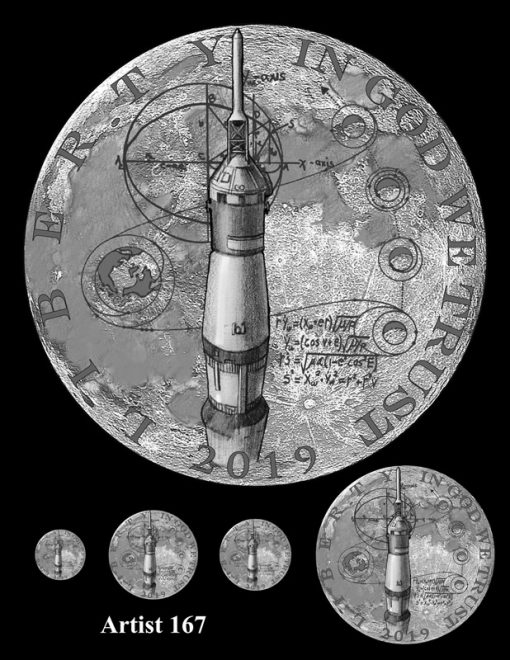
No artist’s narrative provided.
Artist 196
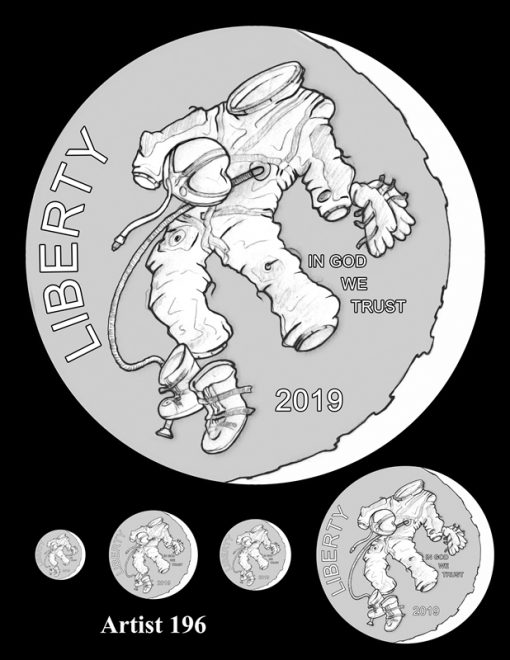
Titled by the artist as "From Space Shot to Moon Landing."
This design depicts the iconic space suit from the Mercury Space Program with the background of a crescent moon.
The suit is arranged in a way as if to appear floating in a weightless environment.
Artist 254
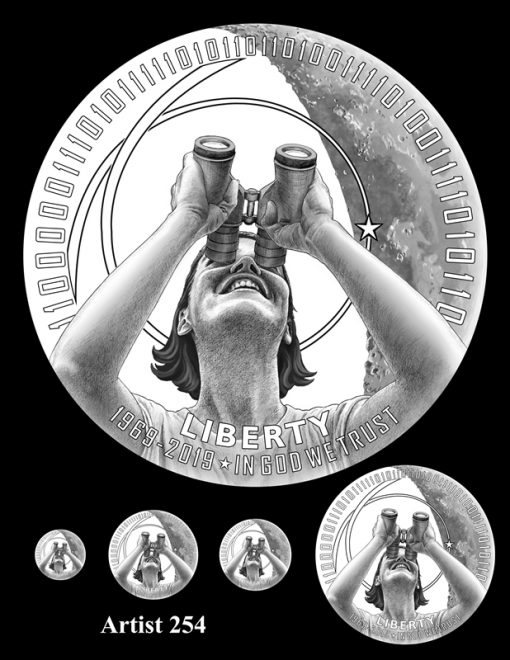
This obverse design shows a woman peering up into the sky with binoculars with the Moon in the background. On the Moon, a star indicates the Apollo 11 landing site, with a circular path coming from and returning to a series of 1s and 0s around the perimeter. The inscriptions "1969-2019," "LIBERTY," and "IN GOD WE TRUST" appear at the bottom.
The string of 1s and 0s is binary code that symbolizes the advanced technology that many dedicated people created and employed in order to land astronauts on the Moon and return them to Earth. Read from left to right, the numbers decrease in size at the top of the design and then return to their starting size at the end; this represents the path that the Command Module would have taken as it left Earth, travelled to the distant Moon’s orbit, and then returned to Earth. For the curious, it is worth noting that this series of 1s and 0s spells the word ‘Apollo’ in Extended Binary Coded Decimal Interchange Code (EBCDIC). EBCDIC is the eight-bit character code that developers would have used in the computers that created the software for the Apollo Guidance Computer (AGC). For its time, the AGC was a sophisticated technological achievement and it was critical to the success of the Apollo 11.
The circular path that leads from the binary code to the landing site on the Moon, and then back to the binary code, symbolizes the path the Lunar Module would have taken from the Command Module to the Moon and back.
The Moon is shown at the approximate phase it would have been (as seen from Earth) on July 20, 1969 — the date that Apollo 11 landed on the Moon.
The woman with binoculars smiles with enthusiasm as she looks toward the sky. She is symbolic of the excitement and support that the U. S. space program generated during all of the Apollo missions, especially the launch and landing of Apollo 11. People crowded the area surrounding the launch site in Florida on July 16, 1969, enduring dense traffic and very hot weather just for a glimpse of the much-anticipated launch. Some of these people used binoculars to get a better view. It is estimated that 530 million people were watching the live television coverage when Neil Armstrong first set foot on the Moon, and it is likely that many of them looked up toward the Moon in wonder on that day. It was as if people everywhere, including the approximately 400,000 people who actually worked on the mission to the Moon, were stakeholders. That kind of widespread public support and enthusiasm is emblematic of the U.S. space program leading up to the first manned Moon landing. Indeed, long after the Apollo 11 astronauts toured the world after their return to Earth, astronaut Michael Collins recalled that the people they’d met felt they had participated in the landing. In the 2007 documentary In the Shadow of the Moon, he said: "People, instead of saying, ‘Well, you Americans did it,’ everywhere they said: ‘We did it!’ We, humankind, we, the human race, we, people did it!"
Artist 265
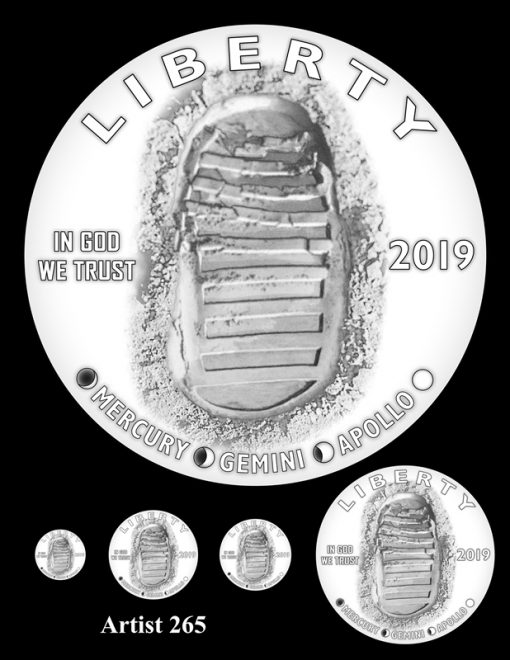
Titled by the artist as "MISSION ACCOMPLISHED!"
The central device is a footprint on the lunar surface left during the Apollo 11 mission.
Artist 273
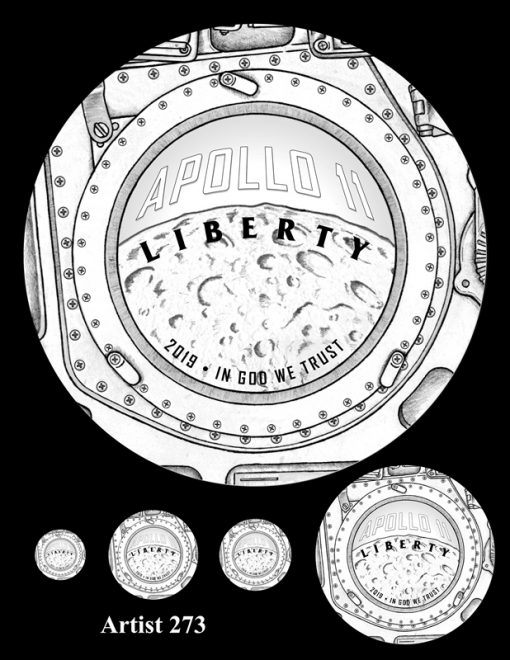
View of the Moon through the window of the Apollo 11 Command Module hatch.
Artist 276
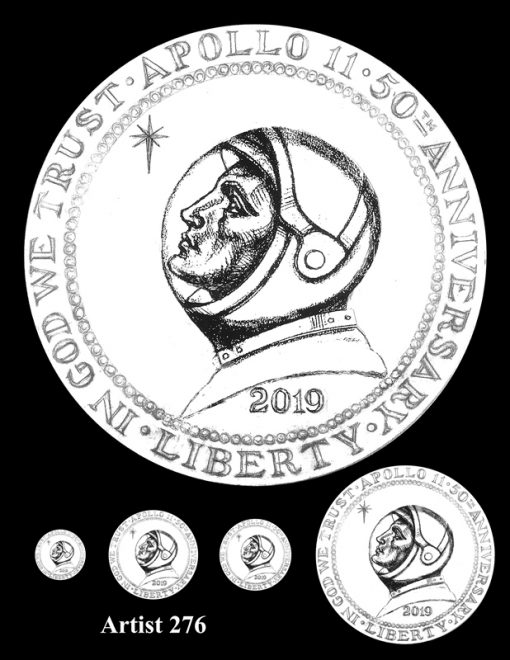
The artist submitted a letter detailing the inspiration behind this design, including human beings rocketing into outer space, our unequaled educational system, and the scientific progress of the United States. The artist further states, "This, above all: we celebrate the awesome courage and skill of our glorious Astronauts," and "AD ASTRA PER ASPERA — To the stars through mighty effort."
Artist 277
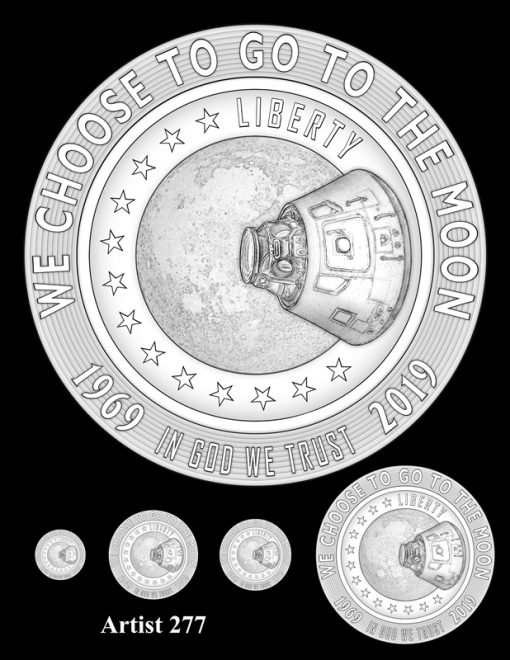
This design features the Apollo 11 Command Module, with the Moon in the background, circumscribed by 13 stars.
The artist desired for the overall image to be suggestive of peering through the eyepiece of a telescope, a concave form that is meant to echo the obverse design’s concave surface.
The phrase, "We Choose To Go To The Moon," quotes President Kennedy from his 1962 speech at Rice Stadium in Houston, Texas. It was one of Kennedy’s earliest speeches meant to persuade the American people to endorse the Apollo program, the national effort to land a man on the Moon.
Artist 279
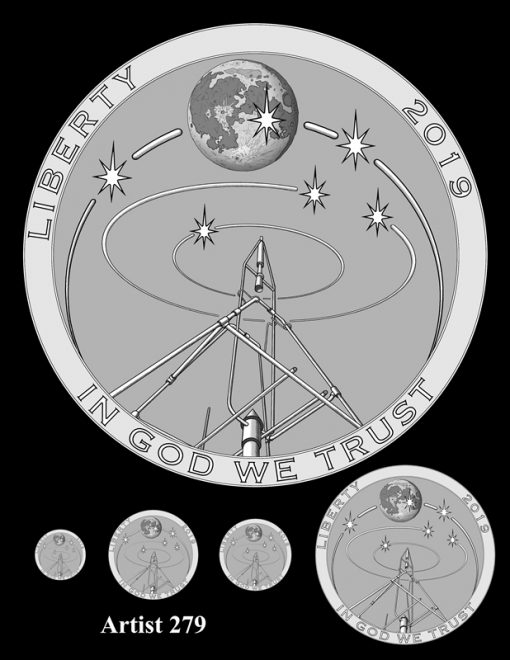
Titled by the artist as "VISION … VOLITION … VICTORY!"
This design is a symbolic representation of America’s path to landing men on the Moon.
The first American made liquid fueled rocket, which is pointing to the future and Apollo 11‘s landing site on the Moon, represents the beginning of the technology and engineering that would be required to send men into space and to the Moon.
Project Mercury launched the first American astronauts into space and were the first American missions to orbit the Earth. They proved that man could survive and work in the harsh environment of space. The single star in orbit represents these flights, each crewed by an individual Mercury astronaut.
Project Gemini was the crucial bridge between orbiting the Earth and going to the Moon. The Gemini astronauts were the first Americans to perform extravehicular activities (EVA), or spacewalks, which provided knowledge for moon walking astronauts. They were also the first, of any nation, to dock two spacecraft together. This was a vital requirement, as the Apollo Command Module and Lunar Module were required to dock in Earth and lunar orbit. Each Gemini spacecraft held two astronauts. I have represented them and the ability to dock with two stars meeting in orbit.
Project Apollo was designed to launch three astronauts to the Moon. Three stars for three astronauts on each crew and also to represent the ascent from Earth, the first landing at Tranquility Base and the safe return to Earth – the basis of President Kennedy’s challenge.
Artist 292
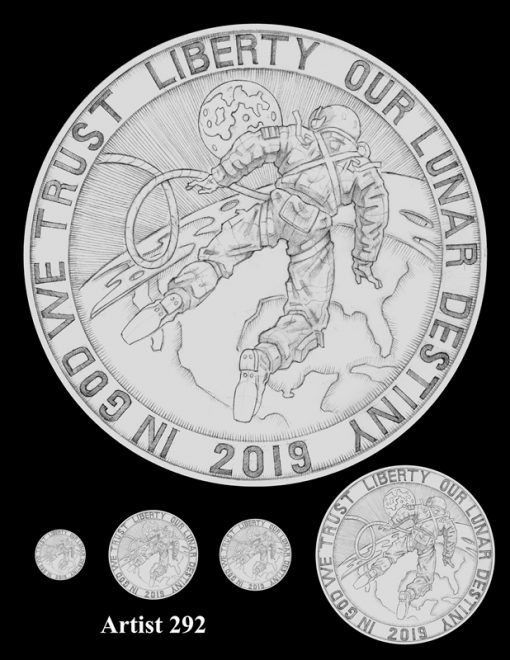
The obverse design submission "Our Lunar Destiny" celebrates the choice to go to the Moon, proclaimed by President Kennedy in his speech at Rice University, along with the resulting commitment and effort to achieve this national goal.
This design pays homage to the pre-lunar historical contributions of the Mercury, Gemini, and Apollo space programs’ research, vision, and desire by advancing the technical knowledge necessary for a future Moon mission.
There are four main visual elements to this design that are arranged in a composition that best tells the story of the years of development in the space industries’ preparation for the eventual Apollo 11 landing: The Earth, the man, the Moon, and the concave nature of the coin itself.
A cloud feature loops its way around the top of the northern hemisphere as it rides the polar jet stream eastward. America’s contour is clearly visible on the Earth’s surface and the American flag patch on the arm of the man’s space suit creates a symbolic relationship between these two elements.
The astronaut hovers in space above the protective atmosphere and gravitational pull of the Earth as he contemplates man’s final quest… the Moon.
Artist 294
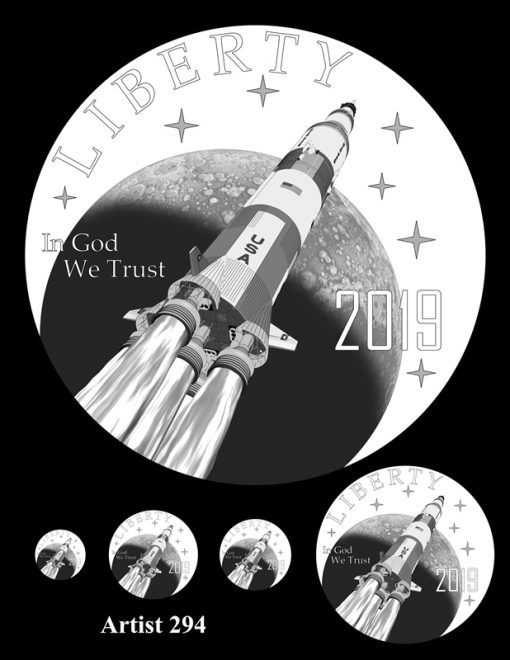
The artist describes this design as follows: "363 feet of gleaming white metal thundered aloft on a bright summer morning, setting a new course for mankind. "The powerful engines of the Saturn V reverberate throughout time, sending out inspiration to artists even today."
Artist 297
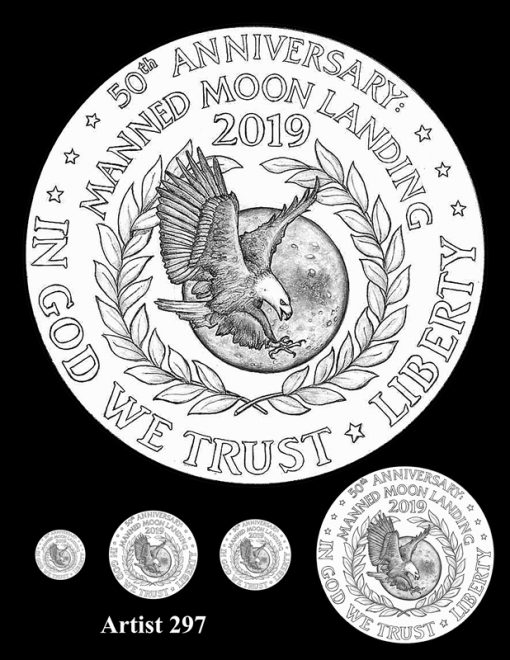
The bald eagle representing America was always a fascinating image for me.
When I started contemplating the assignment for the 50th anniversary coin celebrating Apollo 11, the words of "The Eagle has landed" was an irresistible picturesque image; the American eagle landing on the Moon.
Together with the laurel branches I felt I am illustrating everything the words were expressing on the coin:
America, the Moon landing and the 50th Anniversary.
Artist 308
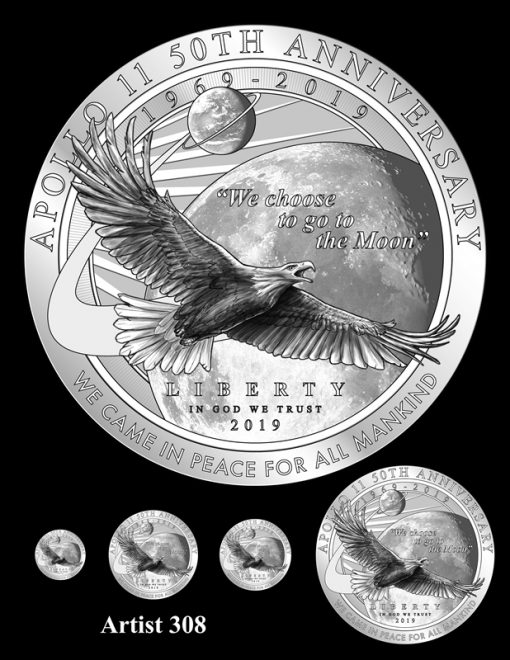
"We choose to go to the Moon"
Symbolic of the epic journey from our home planet to our neighboring satellite, an American Eagle, emblem of the United States, is prominently depicted on a flight from the Earth to the Moon. A symbol of freedom and power, "Eagle" was the name given to the lunar lander used to make the historic first manned landing on the Moon a half-century ago.
Soaring to new heights, the eagle’s grand outstretched wings are a measure of the expansive goals and breadth of mobilization of the Nation’s best minds and industries. Its wide open mouth echoes the bold call to action, "We choose to go to the Moon", expressed by John F. Kennedy in his address at Rice University regarding the Nation’s Space Effort in 1962. It motivated a daring choice of will to pursue space exploration and it inspired the Nation in pursuit of Man’s greatest adventure.
The eagle’s flight path begins by orbiting the Earth, as did the early U.S. space program with unmanned satellites. The path soars outward beyond Earth in a graceful arc leading around the Moon. The Moon is rendered as it would be seen from the Apollo spacecraft in lunar orbit, a unique perspective experienced only by the astronauts who made their triumphant voyage. As an homage to the crew of Apollo 11, the Earth is referenced from a photo taken on their outbound course to the Moon on July 16, 1969.
Illuminating the worlds in space, the Sun’s rays emanate from the word "APOLLO", the Greek god of light and the Sun. Backlighting the eagle, the Sun’s energy advances the intrepid bird forward in Man’s quest for knowledge and enlightenment through discovery and progress.
Underscoring the design and defining the guiding principle upon which the U.S. space program was built, is the phrase, "We came in peace for all Mankind". These words were inscribed on the plaque left on the Moon on the Apollo 11 lunar module decent stage. It is written here in a font similar to that which was printed on the plaque. Perhaps better than any other phrase, it demonstrates the desire for global unity through the spirit of peaceful scientific exploration of space.
Artist 318
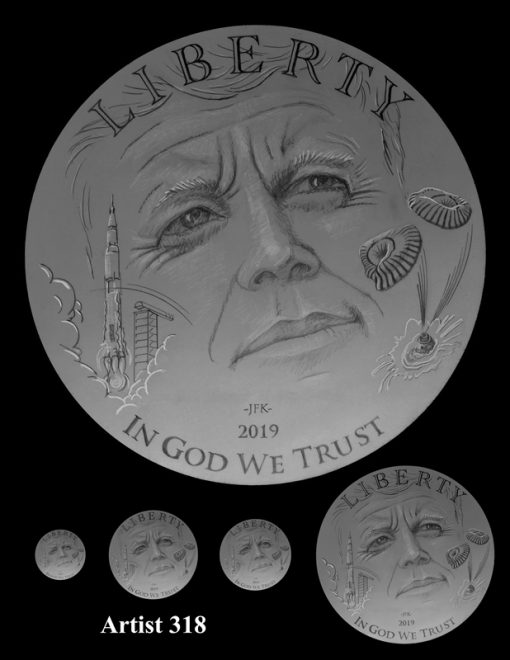
Titled by the artist as "And Return Safely To Earth"
The design intent of this coin’s obverse side is to give tribute to the presidential vision that inspired our country to achieve in less than a decade perhaps the greatest achievement by all mankind.
The scenes, rocket blast-off and splashdown, which frame JFK’s face, are also the two significant events that frame the actual landing represented on the Reverse side of the coin.
Artist 328
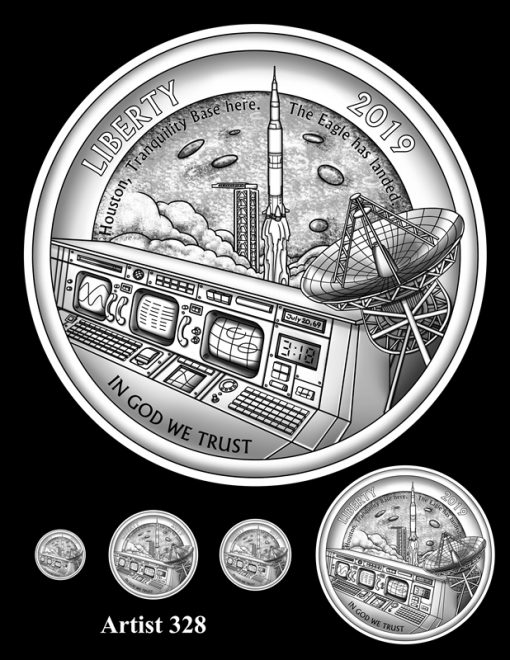
Titled by the artist as "The Heroes on Earth of the Apollo 11"
The artist endeavored with this design to praise all the talented scientists, engineers, and technical support people who worked hard to make the Apollo 11 mission possible.
There is a mission control room pictured on the design. The inspiration came from the historic NASA mission control center in the Space Center Houston, TX.
There is a start of the Saturn V launching rocket shown in the center of the design.
There is a satellite plate pictured on the right.
The Moon craters in the back center are texturally designed to provide the "Moon" bumpy feeling to the one holding the coin.
Artist 337
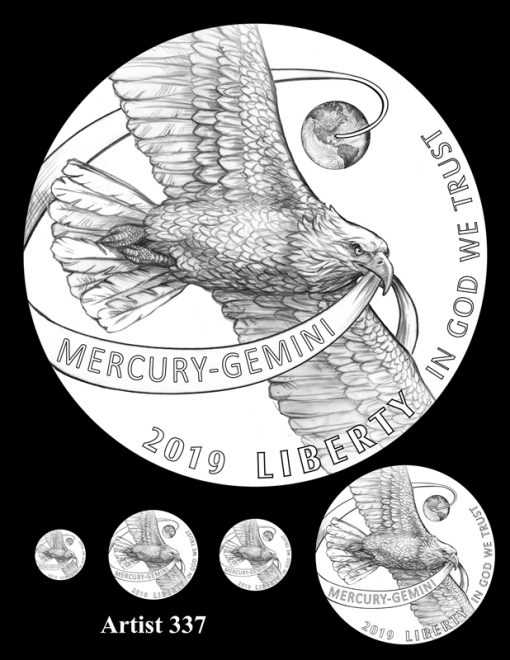
Titled by the artist as "The Eagle Will Land"
This eagle is on a determined mission. It flies forward carrying a banner in his beak with the names of the two NASA programs, Mercury (1958-1963) and Gemini (1961-1966) whose engineering innovations and successes led up to the manned landing on the Moon.
The Earth is in the background with a path representing the trajectory of the 1969 Apollo 11 launch from NASA’s Kennedy Space Center in Florida. That trajectory blends into the banner which the eagle holds securely in its beak… on its way to the Moon with the Apollo 11 crew.
Artist 341
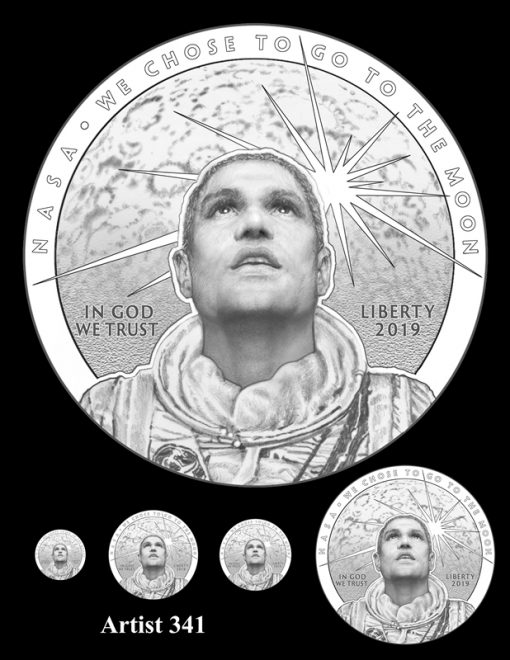
The figure looking up at the Moon in this design is a symbolic personification of the focused and determined spirit of NASA.
Artist 343

Titled by the artist as "On the Shoulders of Giants"
Each mission within the three distinct programs of Mercury, Gemini and Apollo advanced the discoveries and capabilities of the previous and each program stood upon the shoulders of its predecessor.
There were 21 manned missions in total before Neil stepped onto the dust of the lunar surface, six in Mercury, ten in Gemini and five in Apollo.
The design evinces three astronauts from the three programs, shoulder to shoulder. One is in a Mercury spacesuit, one in a Gemini suit and one in an Apollo suit (specifically a Block I spacesuit — discontinued after Apollo 1 — a somewhat unique and different look to complement the reverse of the coin that highlights Apollo 11’s classic Block II visor. The astronauts all look to the ultimate goal, the Moon, and the achievement, "For All Mankind." There are 21 stars, denoting the 21 manned missions previous to the landing and the breadth of the American manned space program.
Artist 346
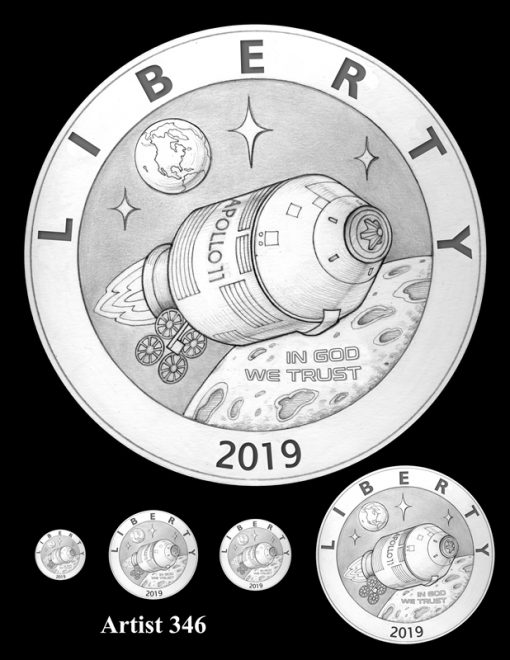
The obverse design features the journey of the Apollo Command Module in space and includes an image of the surface of the Moon and Earth.
When remembering the remarkable feat of the Apollo 11 mission, what often goes unmentioned is that it was first and foremost a team effort, with a huge supporting cast back on Earth, and three astronauts risking their lives in deep space in the name of progress.
The Columbia Command Module is meant to represent the team, the mission as a whole, and not just a single, albeit historic, moment.





